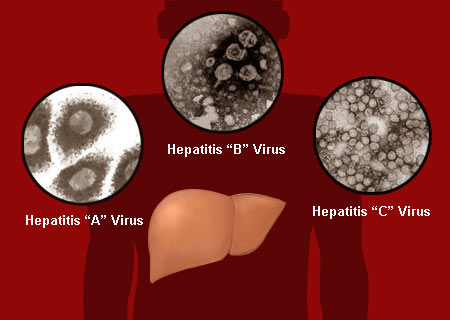The very term Hepatitis sounds as heart-stopping as AIDS or HIV. But as you read further you shall realize that it need not always be as life-threatening as it sounds. Hepatitis or simply put inflammation of the liver ranges from being a simple self-limiting viral infection of the liver cells to permanent scarring due to alcohol. Thus, as one gets labeled as suffering from hepatitis it is very important to understand the cause and its sequels.
The term ‘Hepatitis’ originates from the Greek words ‘Hepat’ meaning liver and ‘itis’ meaning inflammation. It can be acute initiated less than 14 days back or chronic more than 14 days ago.
Acute Hepatitis: The commonest causes for this type are infections. Viral infection most commonly caused by Hepatitis A virus (95%), Hepatitis E (5%). Along with alcoholism and gestation, the other uncommon causes are the following:
Chronic Hepatitis: Chronic alcoholism, Hepatits B virus (with or without hepatitis D) and Hepatitis C virus are the commonest causes. The uncommon causes are:
Clinically, acute hepatitis ranges from asymptomatic illness to fulminant hepatic failure. It might be self-limiting and spontaneously resolving without any treatment or may even require liver transplantation. Usually it begins with flu-like symptoms, loss of appetite, body ache, malaise, fever, nausea and vomiting, diarrhea. Symptoms specific to hepatitis are dark yellow urine, stools, yellowing of the white of the eye (sclera) i.e. jaundice with skin and nails turning yellow later. It also produces an aversion to smoking amongst smokers. It may also cause abdominal discomfort, swelling of lymph nodes in various regions of the body and swelling of the liver which is tender to touch.
While chronic hepatitis, presents in completely different ways, the patients remain mildly symptomatic to completely asymptomatic manifesting only by abnormal blood reports. Sometimes they might come with an acute exacerbation of an underlying chronic liver damage with manifestations of jaundice. Else they might present with swelling of abdomen (ascites), legs (edema), trembling of hands, bleeding tendencies, spider-like naevi, weight loss and an enlarged liver or spleen. There might even be low grade fever.
Investigations that need to be done include Complete Blood Count (CBC), Erythrocyte Sedimentation Rate (ESR), Liver Function Tests (LFT), Prothrombin Time (PT), Urine Routine, Viral markers of the liver-HBsAg, Anti-HCV antibodies, Anti-HEV Antibodies, Anti-HAV antibodies, Ultra-sonography of the abdomen. Based on the results one can identify the basic cause of the hepatitis and then decide the need and speed of treatment.
The dietary changes that one can make while in jaundice are centered in reducing the work load of the liver. Thus heavy meals at one go should be avoided. Small meals should be consumed at short intervals. Rich and fat food should be cut down in the diet. One must eat a high protein and high carbohydrate diet to keep up the immunity and recuperate faster.
Prognosis of the case depends upon the underlying cause. If it’s a viral infection i.e A, E, it is most likely self-limiting and shall resolve within 2-6 weeks with adequate rest. But a Hepatitis virus B or C infection tends to become chronic. Even after the symptoms resolve, these viruses continue to harbor in the body and may become carcinogenic in the long run. To know the viral copies in the blood is the only way to know whether the infection shall become potentially carcinogenic or not.
Since Hepatitis A and E viruses are transmitted through contamination of food and water, cleanliness and hygiene of food and water are the most important precautions one can take. Hepatitis B, C viruses are transmitted through body fluids. Thus sharing of needles, reusing needles, intravenous drug abusing, sex with multiple partners, sharing of razor blades, transferring blood and blood products contaminated with the virus are all potentially hazardous and should be consciously avoided. Screening of all blood should be done before transferring it to a recipient.
A vaccination for Hepatitis A and B is available. It is now a part of birth vaccination programme to be taken in childhood. Those who haven’t been administered the vaccine as a child must take it as adults to increase protection from infection and its complications.
Estimates say that approximately 1,00,000 people in India die either directly due to Hepatitis B or its related complications. Of the 25 million infants born in India every year, at least 1 million run the risk of developing lifelong chronic Hepatitis B infection. Prevention of this rapidly spreading disease is of prime essence and knowledge about the same is therefore of indefinite importance.
-Dr Rachita

